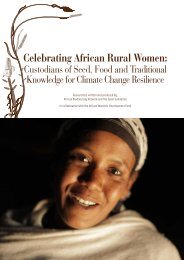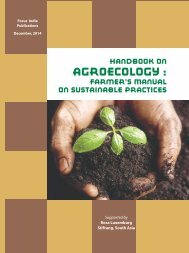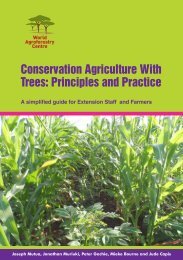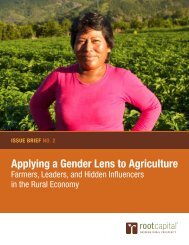1t0SC7l
1t0SC7l
1t0SC7l
You also want an ePaper? Increase the reach of your titles
YUMPU automatically turns print PDFs into web optimized ePapers that Google loves.
family (husband, wife, children); it may receive organic amendment and in some cases<br />
watering.<br />
Animal divagation constitutes the primary threat to home garden development. During the rainy<br />
season, food crop fields and home garden require much labour input, which may lead to weed<br />
invasion in home gardens.<br />
Trees and perennial plantations<br />
Trees play a major role in the farming system. A considerable part of the production value<br />
comes from trees. Despite the price fluctuation in the market of cocoa, it remains an important<br />
cash earner and is grown even in remote villages. Fruit trees are planted in cleared land and are<br />
also harvested during the fallow periods. It is estimated that more than 30 tree species are<br />
planted or preserved for home use or market sale. The oil palm (Elaeis guineensis) is of great<br />
importance, not only for palm oil production, but also as source of palm wine. Palm wine is<br />
tapped from living trees but more often from felled trunks. Brooms, baskets and building<br />
materials may also be derived from oil palms. The Raphia palm provides wine and raw<br />
materials for furniture and house construction. More and more semi-industrial plantations of oil<br />
palm are being established in the TCP area and the phenomenon is likely to continue; more land<br />
will be needed and will be obtained through the clearing of more forest land.<br />
The devaluation of the Franc CFA has not brought the price of cocoa to its original attractive<br />
value; the price still remains low. With the low and fluctuating price, added to the disorganised<br />
marketing system, new cocoa plantations are not being created, and old ones are not being well<br />
maintained. Cocoa as cash earner has lost its leading importance to a series of other cash earners<br />
such as cassava, cocoyam, fruits, palm oil, palm wine and groundnut. The bush butter tree<br />
(Dacryodes edulis) has gained an important economic role; it belongs to the most important<br />
crops sold on the market. Avocado pears (Persea americana) were introduced during early<br />
colonial years and form an important part of the diet and cash earner. Different citrus species<br />
(orange, tangerine, grapefruit, lemon) are part of many cocoa plantations and home gardens<br />
where avocado, guava and mango may also be planted. Fruit trees together with oil palm are<br />
also made part of most fallow lands in the rotational fallow system this might indicate a<br />
potential for planted fallow and might indicate need for research on the suitability of selected<br />
trees in fallow systems.<br />
Fallow type<br />
An increasing number of farmers are adopting the ‘rotational fallow system’, which means<br />
rotating in a total area of less than 10 hectares, where they clear each season. They clear either<br />
Chromolaena fallow (3 to 5 years) to plant groundnut and associated crops, or bush fallow (7 to<br />
9 years) to plant groundnut and plantain with other associated crops, or forest fallow (more than<br />
10 years) or virgin forest to plant cucumber with the associated crops.<br />
The above classification of fallow based on vegetation age classes is the farmers’ definition. It is<br />
difficult for farmers to recall the precise age of a fallow. The type of fallow cleared is highly<br />
linked to the major crops to be grown. Virgin forest and forest fallow (‘Afan’) are cleared to<br />
grow ‘ngon’ with associated crops. Bush fallow (‘Nnom ekotok’) is cleared to grow ‘ngon’ (var.<br />
seng’le) and groundnut with associated crops, or to grow groundnut and plantain with associated<br />
crops. Chromolaena fallow (‘Ekotok Ngoumgoum’) is cleared to grow groundnut and<br />
associated crops. The choice of the virgin forest or forest fallow to clear is based on the<br />
presence of trees and herbs, which indicate good soil fertility (Table 2.12). Other trees and herbs<br />
are indicators of infertile soil (Table 2.13).<br />
2.3.4 Animal system<br />
Reared animals<br />
Though not unimportant, animal husbandry is limited to the rearing of few goats, fowls, pigs<br />
and sheep. It is the second most important activity after crop production according to about 1 / 3<br />
of the farmers interviewed. The ranking by the other 2 / 3 of the population is third and fourth. It<br />
21








